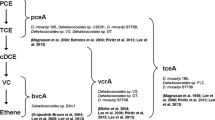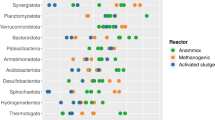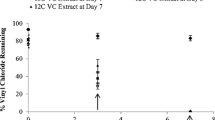Abstract
This study aimed at monitoring the dynamics of phylogenetic and catabolic genes of a dechlorinating enrichment culture before, during, and after complete dechlorination of chlorinated compounds. More specifically, the effect of 40 μM trichloroethene (TCE) and 5.6 mM lactate on the gene abundance and activity of an enrichment culture was investigated for 40 days. Although tceA and vcrA gene copy numbers were relatively stable in DNA extracts over time, tceA and vcrA mRNA abundances were up-regulated from undetectable levels to 2.96 × and 6.33 × 104 transcripts/mL, respectively, only after exposure to TCE and lactate. While tceA gene transcripts decreased over time with TCE dechlorination, the vcrA gene was expressed steadily even when the concentration of vinyl chloride was at undetectable levels. In addition, ratios between catabolic and phylogenetic genes indicated that tceA and vcrA gene carrying organisms dechlorinated TCE and its produced daughter products, while vcrA gene was mainly responsible for the dechlorination of the lower VC concentrations in a later stage of degradation.




Similar content being viewed by others
References
Amos BK, Ritalahti K, Cruz-Garcia C, Padilla-Crespo E, Löffler F (2008) Oxygen effect on Dehalococcoides viability and biomarker quantification. Environ Sci Technol 42:5718–5726
Bælum J, Chambon JC, Scheutz C, Binning PJ, Laier T, Bjerg PJ, Carsten S, Jacobsen CS (2013) A conceptual model linking functional gene expression and reductive dechlorination rates of chlorinated ethenes in clay rich groundwater sediment. Water Res 47:2467–2478
Behrens S, Azizian MF, McMurdie PJ, Sabalowsky A, Dolan ME, Semprini L, Spormann AM (2008) Monitoring abundance and expression of “Dehalococcoides” tetrachloroethene-dechlorinating flow colum. Appl Environ Microbiol 74(18):5695–5703
Doğan-Subaşı E, Bastiaens L, Boon N, Dejonghe W (2013) Microbial dechlorination activity during and after chemical oxidant treatment. J Hazard Mater 262:598–605. doi:10.1016/j.jhazmat.2013.09.003
Dolfing J (1990) Reductive dechlorination of 3-chlorobenzoate is coupled to ATP production and growth in an anaerobic bacterium, strain DCB-1. Arch Microbiol 153:264–266
Gossett JM (1987) Measurements of Henry’s Law constants for C1 and C2 chlorinated hydrocarbons. Environ Sci Technol 21:202–208
Griebler C, Mindl B, Slezak D, Geiger-Kaiser M (2002) Distribution patterns of attached and suspended bacteria in pristine and contaminated shallow aquifers studied with an in situ sediment exposure microcosm. Aquat Microb Ecol 28:117–129
Haest PJ, Philips J, Springael D, Smolders E (2011) The reactive transport of trichloroethene is influenced by residence time and microbial numbers. J Contam Hydrol 119(1–4):89–98
Hamonts K, Kuhn T, Maesen M, Bronders J, Lookman R, Kalka H, Diels L, Meckenstock RU, Springael D, Dejonghe W (2009) Factors determining the attenuation of chlorinated aliphatic hydrocarbons in eutrophic river sediment impacted by discharging polluted groundwater. Environ Sci Technol 43:5270–5275
Haston ZC, McCarty PL (1999) Chlorinated ethene half-velocity coefficients (K S) for reductive dehalogenation. Environ Sci Technol 33:223–226
He J, Ritalahti KM, Aiello MR, Löffler FE (2003) Complete detoxification of vinyl chloride by an anaerobic enrichment culture and identification of the reductively dechlorinating population as a Dehalococcoides species. Appl Environ Microbiol 69:996–1003
He J, Sung Y, Krajmalnik-Brown R, Ritalahti KM, Löffler FE (2005) Isolation and characterization of Dehalococcoides sp. strain FL2, a trichloroethene (TCE) and 1,2-dichloroethene-respiring anaerobe. Environ Microbiol 7:1442–1450
Hendrickx B, Dejonghe W, Boënne W, Brennerova M, Cernik M, Lederer T, Bucheli-Witschel M, Bastiaens L, Verstraete W, Top EM, Diels L, Springael D (2005) Dynamics of an oligotrophic bacterial aquifer community during contact with a groundwater plume contaminated with benzene, toluene, ethylbenzene, and xylenes: an in situ mesocosm study. Appl Environ Microbiol 71:3815–3825
Holmes VF, He JH, Lee KH, Alvarez-Cohen L (2006) Discrimination of multiple dehalococcoides strains in a trichloroethene enrichment by quantification of their reductive dehalogenase genes. Appl Environ Microbiol 72(9):5877–5883
Johnson DR, Lee PKH, Holmes VF, Alvarez-Cohen L (2005a) An internal reference technique for accurately quantifying specific mRNAs by real-time PCR with application to the tceA reductive dehalogenase gene. Appl Environ Microbiol 71:3866–3871
Johnson DR, Lee PKH, Holmes VF, Fortin AC, Alvarez-Cohen L (2005b) Transcriptional expression of the tceA gene in a Dehalococcoides-containing microbial enrichment. Appl Environ Microbiol 71(11):7145–7151
Karl DM (1993) Total microbial biomass estimation derived from the measurement of particulate adenosine-5′-triphospate. In: Kemp PF, Sherr BF, Sherr EB, Cole JJ (eds) Handbook of methods in aquatic microbial ecology. Lewis Publishers, Boca Roton, p 359–367
Kielhorn J, Melber CU, Wahnschaffe A, Mangelsdof I (2000) Vinyl chloride: still a cause for concern. Environ Health Perspect 108:579–588
Lee PKH, Johnson DR, Holmes VF, He J, Alvarez-Cohen L (2006) Reductive dehalogenase gene expression as a biomarker for physiological activity of Dehalococcoides spp. Appl Environ Microbiol 72(9):6161–6168
Lee PKH, Macbeth TW, Sorenson KS, Deeb RA, Alvarez-Cohen L (2008) Quantifying genes and transcripts to assess the in situ physiology of “Dehalococcoides” spp. in a trichloroethene-contaminated groundwater site. Appl Environ Microbiol 74(9):2728–2739
Magnuson JK, Romine MF, Burris DR, Kingsley MT (2000) Trichloroethene reductive dehalogenase from Dehalococcoides ethenogenes: sequence of tceA and substrate range characterization. Appl Environ Microbiol 66(12):5141–5147
Maymo-Gatell X, Chien Y, Gossett JM, Zinder SH, (1997) Isolation of a bacterium that reductively dechlorinates tetrachloroethene to ethene. Science 276:1568–1571
Müller JA, Rosner BM, von Abendroth G, Meshulam-Simon G, McCarty PL, Spormann AM (2004) Molecular identification of the catabolic vinyl chloride reductase from Dehalococcoides sp. strain VS and its environmental distribution. Appl Environ Microbiol 70(8):4880–4888
Muyzer G, De Waal EC, Uitterlinden AG (1993) Profiling of complex microbial populations by denaturing gradient gel electrophoresis analysis of polymerase chain reaction amplified genes encoding for 16S rRNA. Appl Environ Microbiol 59:695–700
Rahm BG, Richardson RE (2008) Dehalococcoides’ gene transcripts as quantitative bioindicators of tetrachloroethene, trichloroethene, and cis-1,2-dichloroethene dehalorespiration rates. Environ Sci Technol 42:5099–5105
Rahm BG, Morris RM, Richardson RE (2006) Temporal expression of respiratory genes in an enrichment culture containing Dehalococcoides ethenogenes. Appl Environ Microbiol 72(8):5486–5491
Ritalahti KM, Amos BK, Sung Y, Wu Q, Koenigsberg SS, Löffler FE (2006) Quantitative PCR targeting 16S rRNA and reductive dehalogenase genes simultaneously monitors multiple Dehalococcoides strains. Appl Environ Microbiol 72:2765–2774
Ritalahti KM, Hatt JK, Lugmayr V, Henn K, Petrovskis EA, Ogles DM, Davis GA, Yeager CM, Lebrón CA, Löffler FE (2010) Comparing on-site to off-site biomass collection for Dehalococcoides biomarker gene quantification to predict in situ chlorinated ethene detoxification potential. Environ Sci Technol 44(13):5127–5133
Scheutz C, Durant ND, Dennis P, Hansen MH, Jørgensen T, Jakobsen R, Cox EE, Bjerg PL (2008) Concurrent ethene generation and growth of Dehalococcoides containing vinyl chloride reductive dehalogenase genes during an enhanced reductive dechlorination field demonstration. Environ Sci Technol 42:9302–9309
Schippers A, Neretin LN (2006) Quantification of microbial communities in near-surface and deeply buried marine sediments on the Peru continental margin using real-time PCR. Environ Microbiol 8(7):1251–1260
SERDP & ESTCP Expert Panel Workshop: Research & Development Needs for the Environmental Remediation Application of Molecular Biological Tools, 2005
Smidt H, de Vos WM (2004) Anaerobic microbial dehalogenation. Ann Rev in Microbiol 58:43–73
Sung Y, Ritalahti KM, Apkarian RP, Löffler FE (2006) Quantitative PCR confirms purity of strain GT, a novel trichloroethene-to-ethene-respiring Dehalococcoides isolate. Appl Environ Microbiol 72(3):1980–1987
van der Zaan B, Hannes F, Hoekstra N, Rijnaarts H, de Vos WM, Smidt H, Gerritse J (2010) Correlation of Dehalococcoides 16S rRNA and chloroethene-reductive dehalogenase genes with geochemical conditions in chloroethene-contaminated groundwater. Appl Environ Microbiol 76(3):843–850
Acknowledgments
The research has received funding from the European Community’s Seventh Framework Program FP7/2007-2013 under Grant agreement no 212683 (GOODWATER). Contributions of Wietse Heylen, Queenie Simons and Yamini Satyawali are appreciated.
Author information
Authors and Affiliations
Corresponding author
Rights and permissions
About this article
Cite this article
Doğan-Subaşı, E., Bastiaens, L., Leys, N. et al. Quantitative and functional dynamics of Dehalococcoides spp. and its tceA and vcrA genes under TCE exposure. Biodegradation 25, 493–504 (2014). https://doi.org/10.1007/s10532-013-9676-8
Received:
Accepted:
Published:
Issue Date:
DOI: https://doi.org/10.1007/s10532-013-9676-8




